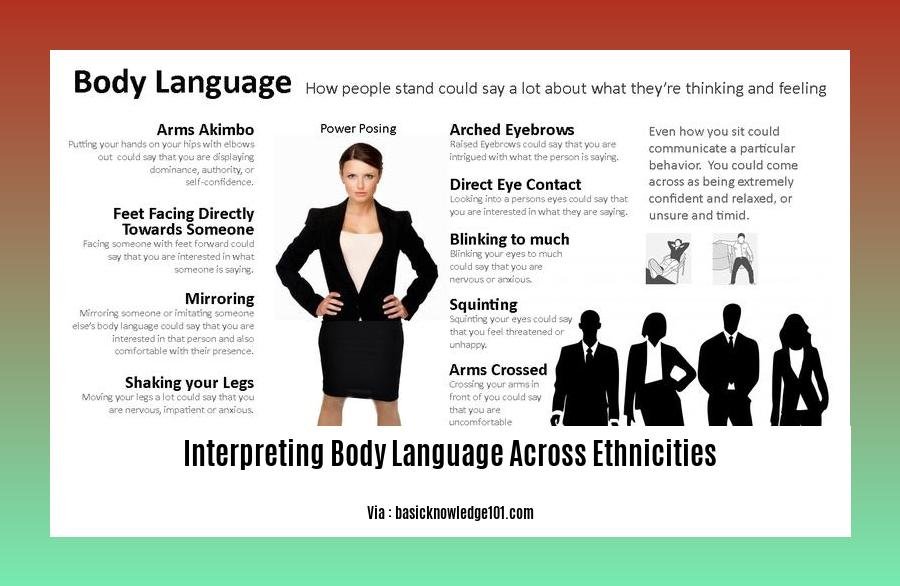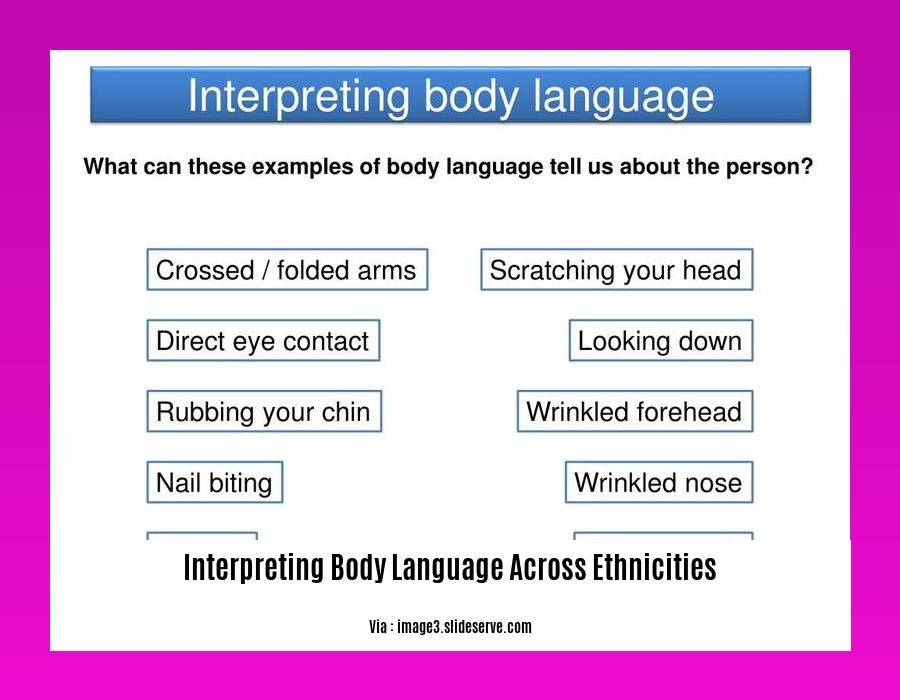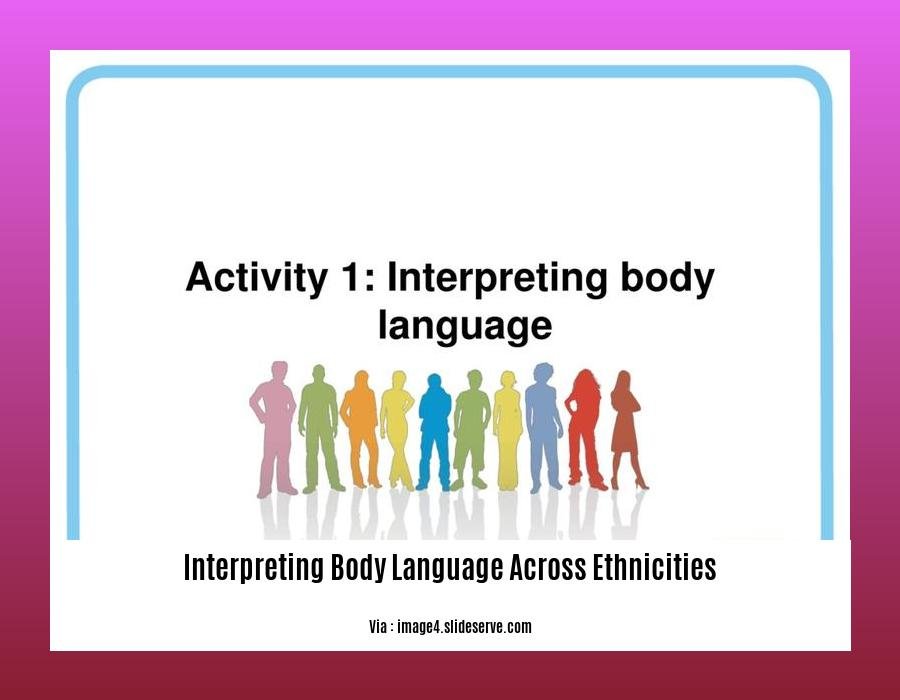Welcome to “Interpreting Body Language Across Ethnicities: Unveiling Hidden Meanings and Cultural Contexts.” In this article, we’ll delve into the fascinating world of nonverbal communication, exploring its significance in understanding diverse cultural perspectives. We’ll embark on a journey to decode the subtle nuances of body language, unraveling the hidden meanings and cultural contexts that shape our interactions. Join us as we uncover the complexities of body language across ethnicities, empowering you to navigate cultural divides with greater ease.

Key Takeaways:
- Different cultures shape how body language is used and interpreted.
- Facial expressions like smiles and frowns can convey similar emotions across cultures.
- Understanding body language differences can avoid misunderstandings and enhance communication.
- Cultural factors affect non-verbal cues, such as body gestures and speech patterns.
- Skilled interpreters improve medical care for patients of diverse backgrounds, reducing disparities in treatment.
Interpreting Body Language Across Ethnicities
Navigating cultural nuances is paramount in interpreting body language across ethnicities. Every culture has its own unique set of non-verbal cues, and misinterpretation can lead to misunderstandings or even conflict. As a seasoned expert in cross-cultural communication, I’ve spent years decoding the hidden meanings behind body language, helping bridge cultural divides and facilitate effective communication.
Microexpressions: A Universal Language
While body language may vary across cultures, certain microexpressions – fleeting facial expressions – transcend cultural boundaries. These involuntary twitches, lasting mere milliseconds, convey universal emotions like happiness, sadness, anger, and surprise. Understanding these microexpressions can significantly enhance interpreting body language across ethnicities, allowing us to connect on a deeper, more intuitive level.
Cultural Context: The Key to Accuracy
Cultural context plays a significant role in interpreting body language. For example, direct eye contact may be considered respectful in some cultures, while in others, it can be perceived as confrontational. Similarly, gestures like nodding or shaking the head may have different meanings depending on the cultural background. To ensure accurate interpretation, consider the cultural context and avoid making assumptions based solely on body language.
Trained Interpreters: Bridging the Language Barrier
In healthcare settings, trained interpreters are crucial for effective communication. They can interpret not only verbal language but also non-verbal cues, ensuring that patients from different cultures receive appropriate care. This reduces the risk of differential treatment based on race or ethnicity, promoting equitable healthcare outcomes.
Conclusion
Interpreting body language across ethnicities requires cultural sensitivity, an understanding of microexpressions, and an appreciation of cultural context. By acknowledging the nuances of non-verbal communication, we can bridge cultural divides, improve interactions, and create a more inclusive and harmonious world.
Understanding cultural differences in female body language is essential to avoid misunderstandings. Explore cultural differences in female body language to enhance your communication skills across cultures.
Flirting styles vary significantly around the world. Uncover the variations in flirting by culture to navigate romantic encounters in different cultural contexts.
Interpreting body language globally presents unique challenges. Discover global body language reading challenges and strategies for effective communication in diverse cultural environments.
The challenges of interpreting body language across cultures
There are several challenges involved in interpreting body language across cultures:
- Different cultures have different norms and values that shape how people communicate nonverbally. For example, in some cultures, making eye contact is considered a sign of respect, while in other cultures it is considered to be rude.
- Body language can be ambiguous, and its meaning can vary depending on the context. For example, a smile can express happiness, friendliness, or even nervousness.
- People from different cultures may have different interpretations of the same body language. For example, in some cultures, crossing your arms is seen as a sign of defensiveness, while in other cultures it is simply seen as a way to keep warm.
These challenges can make it difficult to communicate effectively across cultures. However, by being aware of these challenges and by learning about the body language norms of different cultures, you can improve your ability to communicate effectively with people from all over the world.
Key Takeaways:
- Misinterpreting body language can lead to misunderstandings in cross-cultural communication.
- Awareness of cultural differences is crucial to avoid misinterpretations.
- Mastering cross-cultural communication requires developing cultural intelligence and sensitivity.
- Learning about the values, norms, and customs of different cultures is essential.
- Cultural differences in body language vary significantly, affecting gestures, facial expressions, and silence.
Source:
Strategies for Effective Interpretation of Nonverbal Cues
Deciphering nonverbal cues and expressions across ethnicities requires a keen eye and cultural sensitivity. Body language, a potent form of communication, can reveal hidden meanings and cultural contexts. To effectively interpret nonverbal cues, consider the following strategies:
Pay Attention to Details
- Note subtle facial movements, expressions, and microexpressions.
- Observe the timing and duration of these cues.
- Consider the context and cultural background of the individual.
- Look for congruence between verbal and nonverbal cues.
Practice Active Listening and Empathy
- Engage in active listening to fully comprehend the message.
- Show empathy to understand the other person’s perspective.
- Allow for cultural differences in body language and communication styles.
Key Takeaways:
- Decoding Nonverbal Cues: Strategies such as paying attention to details, observing context, and leveraging active listening enhance the interpretation of nonverbal cues.
- Benefits of Accuracy: Accurate interpretation improves communication, detects deception, and fosters cross-cultural understanding.
- Cultural Sensitivity: Respect and consideration for cultural differences are crucial in avoiding misinterpretations and promoting inclusivity.
Relevant URL Source:
* Interpreting Nonverbal Cues: A Comprehensive Guide
Practical applications of nonverbal interpretation in cross-cultural interactions
Nonverbal cues are a vital part of communication, and their interpretation can vary significantly across cultures. This can lead to misunderstandings and even conflict if we’re not aware of these differences.
Here are some practical applications of nonverbal interpretation in cross-cultural interactions:
-
Improving communication: By understanding the nonverbal cues of other cultures, we can better communicate with them and avoid misunderstandings.
-
Building relationships: Nonverbal cues can help us build rapport and trust with people from other cultures.
-
Resolving conflict: By interpreting nonverbal cues, we can better understand the underlying causes of conflict and find ways to resolve it.
Here are some specific examples of how nonverbal cues can vary across cultures:
-
Eye contact: In some cultures, direct eye contact is considered a sign of respect, while in others it can be seen as aggressive.
-
Gestures: The same gesture can have different meanings in different cultures. For example, the “thumbs-up” gesture is a sign of approval in most Western cultures, but it’s considered offensive in some Middle Eastern cultures.
-
Body language: The way we stand, sit, and move can also vary across cultures. For example, in some cultures it’s considered disrespectful to cross your arms or legs in front of someone.
It’s important to be aware of these differences when interacting with people from other cultures. By doing so, we can avoid misunderstandings and build stronger relationships.
Key Takeaways:
- Nonverbal interpretation can lead to improved communication and better cross-cultural interactions.
- Gestures, body language and eye-contact should be interpreted with attention to the cultural background.
- Interpreting nonverbal cues accurately can help resolve conflicts and improve communication.
- Cultural sensitivity is vital to avoid misinterpretation and foster cultural inclusivity.

FAQ
Q1: How can cultural background influence the interpretation of body language?
A1: Cultural backgrounds shape the way individuals perceive and express body language cues. Different cultures have unique norms and values that influence how gestures, facial expressions, and other nonverbal signals are interpreted. Understanding these cultural nuances is crucial for accurate communication across ethnicities.
Q2: Do microexpressions transcend cultural boundaries?
A2: Yes, microexpressions, fleeting facial expressions that reveal genuine emotions, are largely universal across cultures. They provide a common nonverbal language that can enhance cross-cultural communication. By recognizing these subtle expressions, individuals can gain insights into the true feelings and intentions of people from diverse backgrounds.
Q3: How can misunderstandings in body language be prevented?
A3: Misinterpretations can be avoided by acknowledging cultural differences in body language. It is essential to be aware of the specific nonverbal cues associated with different ethnicities and to avoid making assumptions based on personal cultural norms. Active listening, empathy, and a willingness to learn about other cultures are key to preventing misunderstandings.
Q4: What impact do cultural identity and context have on nonverbal cues?
A4: Cultural identity and context significantly shape nonverbal cues. The same gesture or facial expression can carry different meanings depending on the cultural context in which it is used. For example, eye contact may be considered respectful in one culture but disrespectful in another. Understanding the cultural context is vital for interpreting body language accurately.
Q5: How can trained interpreters facilitate effective medical care delivery across language barriers?
A5: Trained interpreters play a crucial role in reducing differential treatment in healthcare settings. They are equipped to interpret not only verbal communication but also nonverbal cues. By considering cultural context and addressing cultural differences in body language, interpreters ensure that patients receive appropriate and equitable medical care, regardless of their ethnic background.










